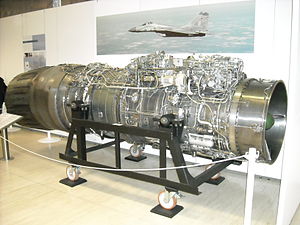Klimov RD-33
| RD-33 | |
|---|---|

| |
| RD-33 on display at the Air Force Museum of the Bundeswehr | |
| Type | Turbofan |
| Manufacturer | Klimov |
| First run | 1974 |
| Major applications | Mikoyan MiG-29 Mikoyan MiG-35 Dassault Mirage F1 CAC/PAC JF-17 Thunder |
The Klimov RD-33 is a turbofan jet engine for a lightweight fighter jet that is the primary engine for the Mikoyan MiG-29 and CAC/PAC JF-17 Thunder. It was developed in OKB-117 led by S. P. Izotov (now OAO Klimov) from 1968 with production starting in 1981. Previous generations of Russian supersonic fighters such as the MiG-21 and MiG-27 used turbojets, but western fighters such as the F-111 and F-4K introduced the use of afterburning turbofans in the 1960s which were more efficient. The RD-33 was the first afterburning turbofan engine produced by the Klimov company of Russia in the 8,000 to 9,000 kilograms-force (78,000 to 88,000 N; 18,000 to 20,000 lbf) thrust class. It features a modular twin-shaft design with individual parts that can be replaced separately and has a good tolerance to the environment. The RD-33 is simple to maintain and retains good performance in challenging environments.[1]
Variants
In early 1970s the RD-33 was selected for new light fighter jet, later becoming Mikoyan MiG-29, the other option was Tumansky R-67-300.[2] Years of development has built an extensive engine family. A newly designed thrust vectoring nozzle (TVN) is now available. New models of the RD-33 family include BARK digital monitoring and control systems. Repair and maintenance of RD-33 engines takes advantage of an information and diagnostics system (IDS).
RD-33
Baseline model developed in 1976 to power the MiG-29.
RD-33B/NB
A model without afterburner for various types of aircraft, such as the Il-102.
RD-93
A variant used to power the JF-17 (FC-1). According to JF-17.com "The most significant difference being the repositioning of the gearbox along the bottom of the engine casing." The Klimov poster at Zhuhai 2010 airshow gave the thrust range of the engine to be 79 kN Dry to 98 kN Wet.[3] This was designed specifically for FC-1 with increased thrust and relocated gearbox compared to base RD-33's. Although the increase of thrust decreased the service life of RD-93 to 2200 hours from RD-33's 4000 hours. According to Air Commodore Mehmood engines are solid and reliable: “We’ve flown 7,000 hours with the engine and we haven’t had any problems”, he said [4]
SMR-95

A model for upgrading international 2nd and 3rd generation jet fighters. The accessory gearbox is repositioned below the engine, length can be varied depending on the adopted aircraft fuselage. The engine passed bench tests and flight tests on the Super Mirage F-1 and Super Cheetah D-2 aircraft of the South African Air Force and had achieved an improvement in flight performance and combat efficiency by a factor ranging from 1.2 to 3.0.[5]
RD-33 series 3
A revised model with a longer service life used on later or upgraded old variants of the MiG-29 such as MiG-29M and MiG-29SMT.[6][7] A pair of RD-33 series 3 engine equipped with TVN is currently undergoing flight tests as a component of the MiG-29OVT jet fighter.[8]
RD-33MK
The RD-33MK "Morskaya Osa" (Russian: Морская Оса: "Sea Wasp") is the latest model developed in 2001. It is intended to power the MiG-29K and MiG-29KUB shipborne fighters, however it has also been adopted for the MiG-35. The RD-33MK develops 7% higher thrust, is digitally controlled FADEC and smokeless unlike earlier RD-33 engines, has increased afterburner thrust to 9,000 kilograms-force (88,000 N; 20,000 lbf) and dry weight 1,145 kilograms (2,524 lb) compared to the baseline model through modern materials used on the cooled blades, although it retains the same length and maximum diameter. Incorporated is an infrared and optical signature visibility reduction systems. Service life has been increased to 4,000 hours. The RD-33MK ensures shipborne fighters unassisted take-off capability, retain performance in hot climate environment and, naturally, a boost in combat efficiency for MiG-29 fighter latest variant.[9][10]
Specifications (RD-33)
Data from Janes Aero Engines, Klimov Website
General characteristics
- Type: afterburning turbofan
- Length: 4,229 mm (166.50 in)
- Diameter: 1,040 mm (40.94 in)
- Dry weight: 1,055 kg (2,326 lb)
Components
- Compressor: 2 spool axial, 4 low pressure stages, 9 high pressure stages
- Combustors: annular combustor
- Turbine: Single stage high pressure, single stage low pressure
Performance
- Maximum thrust: 50.0 kN (11,230 lbf) Dry, 81.3 kN (18,285 lbf) Afterburning.
- Overall pressure ratio: 21:1
- Bypass ratio: 0.49:1
- Turbine inlet temperature: 1,407 °C (2,565 °F)
- Specific fuel consumption: 75 kg/(kN·h) (0.77 lb/(lbf·h)) dry, 188 kg/(kN·h) (1.85 lb/(lbf·h))
- Thrust-to-weight ratio: 4.82:1 (dry), 7.9:1 (afterburning)
- Life expectancy: 4,000 hours
See also
Comparable engines
Related lists
References
- ^ Template:Ru icon Klimov :: Production :: Aircraft Program :: RD-33 family
- ^ MiG-29 development history on Airwar.ru
- ^ http://i56.tinypic.com/n3vu4x.jpg
- ^ Air international nr.6 december 2013
- ^ Template:Ru icon Klimov :: Production :: Aircraft Program :: SMR-95
- ^ Template:Ru icon Rac Mig Archived 2007-07-06 at the Wayback Machine
- ^ Template:Ru icon Rac Mig
- ^ Template:Ru icon Klimov :: Production :: Aircraft Program :: Trust Vertoring Nozzle
- ^ Template:Ru icon Klimov :: Production :: Aircraft Program :: RD-33MK
- ^ http://klimov.ru/f/download/press-kit/2100054687/2100054340/
External links
- Klimov official site page of RD-33 Turbofan engine family
- Official site page of RD-33MK
- Official site page of Thrust vector nozzle
- Official site page of SMR-95
- Official document: Prospective Project Developments 2007
- RD-93 for JF-17 / FC-1
- India to Build RD-33 under license
- India to make Mig 29 Engines with Russia
- RD-33 - history, versions, technical description (czech)
- RD-33 on Airwar.ru (russian)
